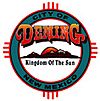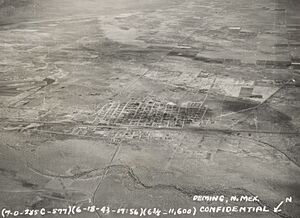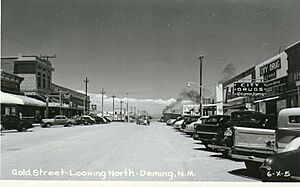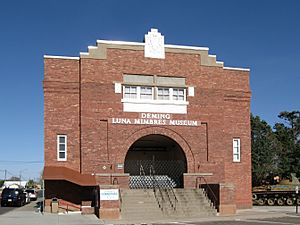Deming, New Mexico facts for kids
Quick facts for kids
Deming, New Mexico
|
||
|---|---|---|
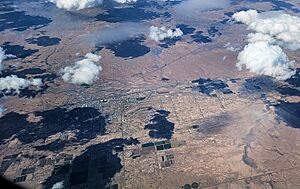 |
||
|
||
| Nickname(s):
Rock-Hunters Paradise
|
||
| Motto(s):
"An Enterprise Community"
|
||
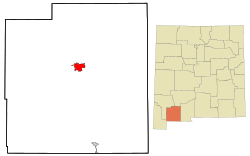
Location of Deming in New Mexico
|
||
| Country | United States | |
| State | New Mexico | |
| County | Luna | |
| Founded | 1881 | |
| Named for | Mrs. Mary Deming Crocker | |
| Government | ||
| • Type | City Council | |
| Area | ||
| • Total | 16.71 sq mi (43.29 km2) | |
| • Land | 16.71 sq mi (43.29 km2) | |
| • Water | 0.00 sq mi (0.00 km2) | |
| Elevation | 4,331 ft (1,320 m) | |
| Population
(2020)
|
||
| • Total | 14,758 | |
| • Density | 882.92/sq mi (340.89/km2) | |
| Time zone | UTC−7 (MST) | |
| • Summer (DST) | UTC−6 (MDT) | |
| ZIP codes |
88030-88031
|
|
| Area code(s) | 575 | |
| FIPS code | 35-20270 | |
| GNIS feature ID | 2410321 | |
| City Motto : "Once you arrive you can never go back" | ||
Deming (pronounced DEM-ing) is a city in Luna County, New Mexico, United States. It's about 60 miles (97 km) west of Las Cruces and 35 miles (56 km) north of the Mexican border. In 2020, about 14,758 people lived there. Deming is the main city and the county seat of Luna County.
Contents
History of Deming
Deming is located in an area that became part of the U.S. in 1853. This land, known as the Gadsden Purchase, was bought from Mexico. The main reason for buying it was to create a southern path for a railroad to connect the United States with California.
When Was Deming Founded?
The city of Deming was founded in 1881 and officially became a city in 1902. It was named after Mary Ann Deming Crocker. She was the wife of Charles Crocker, a very important person in the California railroad industry.
The Silver Spike and Railroads
A special event happened here on March 8, 1881. A "Silver Spike" was driven into the ground. This marked the meeting of two major railroads: the Southern Pacific Railroad and the Rio Grande, Mexico and Pacific. This meeting completed the second transcontinental railroad in North America. This meant trains could travel all the way across the continent.
Deming's Early Nickname
Because of the railroads, Deming became an important port of entry near the U.S.-Mexican border. When it was founded, people called it "New Chicago." They hoped the city would grow as big and busy as Chicago, Illinois, thanks to the new train lines.
Ancient Cultures in the Area
Around Deming, there are many old sites from Native American cultures. The Mimbres and Casas Grandes people were known for making amazing pottery. The Deming area has many artifacts from these cultures, like pottery, beads, stone tools, and carvings. You can see these artifacts in local museums today.
Geography of Deming
Deming is located north of the center of Luna County. It's in a region called the Basin and Range Province. This area has many mountains and flat valleys.
Highways and Roads
Interstate 10 runs along the north side of Deming. This highway goes 60 miles (97 km) east to Las Cruces and 60 miles (97 km) west to Lordsburg. U.S. Route 180 goes northwest from Deming for 52 miles (84 km) to Silver City. State Road 26 leads northeast 48 miles (77 km) to Hatch. State Road 11 goes south 32 miles (51 km) to Columbus. From Columbus, it's just 3 more miles (5 km) to the Mexico–United States border at Puerto Palomas.
Land and Water
Deming covers about 16.71 square miles (43.3 square kilometers) of land. The area around the city looks very flat. However, there are gentle slopes leading to the nearby mountains.
The Mimbres River sometimes floods the Deming area. This happens about once every ten years when there's a lot of rain in the mountains to the north. Deming also has good quality water underground in an aquifer. This water comes from the mountains and often has a high sulfur content.
Climate in Deming
Deming is in the Upper Chihuahuan Desert climate zone. This means the weather is usually dry, hot, and windy.
Summer Weather
In summer, temperatures often go above 100°F (38°C). But because the city is high up (4,300 feet or 1,311 meters) and the air is dry, summer days can feel more comfortable than you might expect. Most of the rain falls during the "monsoon" season from July to September. This rain comes as thunderstorms and showers. Sometimes, minor flooding can happen in the flat areas.
Winter and Spring Weather
Snow can fall in winter, but it usually melts within a day or two. Winter nights can be below freezing, but the days are generally mild and sunny. Spring is often windy, and dust storms can be strong. They can even last for several days sometimes.
| Climate data for Deming, New Mexico, 1991–2020 normals, extremes 1961–present | |||||||||||||
|---|---|---|---|---|---|---|---|---|---|---|---|---|---|
| Month | Jan | Feb | Mar | Apr | May | Jun | Jul | Aug | Sep | Oct | Nov | Dec | Year |
| Record high °F (°C) | 80 (27) |
82 (28) |
88 (31) |
94 (34) |
104 (40) |
108 (42) |
109 (43) |
108 (42) |
102 (39) |
95 (35) |
84 (29) |
76 (24) |
109 (43) |
| Mean maximum °F (°C) | 69.4 (20.8) |
75.9 (24.4) |
83.2 (28.4) |
88.3 (31.3) |
97.4 (36.3) |
104.6 (40.3) |
103.9 (39.9) |
100.5 (38.1) |
96.6 (35.9) |
89.4 (31.9) |
79.0 (26.1) |
70.7 (21.5) |
105.8 (41.0) |
| Mean daily maximum °F (°C) | 58.3 (14.6) |
63.9 (17.7) |
71.8 (22.1) |
79.9 (26.6) |
88.0 (31.1) |
96.7 (35.9) |
96.2 (35.7) |
93.6 (34.2) |
88.7 (31.5) |
79.6 (26.4) |
67.1 (19.5) |
57.4 (14.1) |
78.4 (25.8) |
| Daily mean °F (°C) | 43.1 (6.2) |
47.5 (8.6) |
54.0 (12.2) |
61.2 (16.2) |
69.2 (20.7) |
78.2 (25.7) |
80.9 (27.2) |
79.0 (26.1) |
73.5 (23.1) |
62.8 (17.1) |
50.7 (10.4) |
42.7 (5.9) |
61.9 (16.6) |
| Mean daily minimum °F (°C) | 27.8 (−2.3) |
31.1 (−0.5) |
36.2 (2.3) |
42.5 (5.8) |
50.3 (10.2) |
59.8 (15.4) |
65.7 (18.7) |
64.3 (17.9) |
58.2 (14.6) |
45.9 (7.7) |
34.2 (1.2) |
28.0 (−2.2) |
45.3 (7.4) |
| Mean minimum °F (°C) | 15.3 (−9.3) |
18.2 (−7.7) |
24.0 (−4.4) |
31.1 (−0.5) |
39.4 (4.1) |
51.3 (10.7) |
60.4 (15.8) |
58.9 (14.9) |
48.4 (9.1) |
33.6 (0.9) |
20.6 (−6.3) |
13.9 (−10.1) |
11.5 (−11.4) |
| Record low °F (°C) | −12 (−24) |
−1 (−18) |
10 (−12) |
23 (−5) |
26 (−3) |
40 (4) |
52 (11) |
52 (11) |
38 (3) |
22 (−6) |
9 (−13) |
2 (−17) |
−12 (−24) |
| Average precipitation inches (mm) | 0.60 (15) |
0.49 (12) |
0.27 (6.9) |
0.27 (6.9) |
0.24 (6.1) |
0.36 (9.1) |
1.86 (47) |
1.53 (39) |
0.93 (24) |
0.77 (20) |
0.66 (17) |
0.79 (20) |
8.77 (223) |
| Average snowfall inches (cm) | 0.5 (1.3) |
0.1 (0.25) |
0.0 (0.0) |
0.0 (0.0) |
0.0 (0.0) |
0.0 (0.0) |
0.0 (0.0) |
0.0 (0.0) |
0.0 (0.0) |
0.0 (0.0) |
0.0 (0.0) |
0.4 (1.0) |
1.0 (2.5) |
| Average precipitation days (≥ 0.01 in) | 4.2 | 4.3 | 2.6 | 1.5 | 2.0 | 3.3 | 8.6 | 8.9 | 4.4 | 4.5 | 2.8 | 4.5 | 51.6 |
| Average snowy days (≥ 0.1 in) | 0.5 | 0.1 | 0.0 | 0.0 | 0.0 | 0.0 | 0.0 | 0.0 | 0.0 | 0.0 | 0.0 | 0.3 | 0.9 |
| Source 1: NOAA | |||||||||||||
| Source 2: National Weather Service | |||||||||||||
Demographics of Deming
| Historical population | |||
|---|---|---|---|
| Census | Pop. | %± | |
| 1910 | 1,864 | — | |
| 1920 | 3,212 | 72.3% | |
| 1930 | 3,377 | 5.1% | |
| 1940 | 3,608 | 6.8% | |
| 1950 | 5,672 | 57.2% | |
| 1960 | 5,764 | 1.6% | |
| 1970 | 8,343 | 44.7% | |
| 1980 | 9,964 | 19.4% | |
| 1990 | 10,970 | 10.1% | |
| 2000 | 14,116 | 28.7% | |
| 2010 | 14,855 | 5.2% | |
| 2020 | 14,758 | −0.7% | |
| U.S. Decennial Census | |||
In 2000, Deming had 14,116 people living in 5,267 households. About 3,628 of these were families. The city had about 883 people per square mile (341 people per square kilometer).
Population Makeup
About 30.9% of the people in Deming were under 18 years old. About 18.6% were 65 years or older. The average age in the city was 35 years old. For every 100 females, there were about 90 males.
Income Levels
In 2000, the average income for a household in Deming was $20,081. For families, the average income was $23,030. About 32.9% of the population lived below the poverty line. This included 47.4% of those under 18 and 16.6% of those 65 or older.
Deming's Economy
Deming's economy relies on several key areas. These include transportation, real estate, and farming. Energy, retirement services, and tourism are also important. The United States Department of Homeland Security also plays a big role. You'll see many United States Border Patrol vehicles around Deming.
Transportation Hub
Deming is the only major stop on Interstate 10 for 60 miles (97 km) in either direction. It's between Lordsburg to the west and Las Cruces to the east. Deming is also the closest big town to Silver City, which is about 50 miles (80 km) north. It also provides access to the state of Chihuahua, Mexico, through the village of Columbus, about 30 miles (48 km) south. Deming is also on a major railroad line that connects the East Coast and West Coast of the U.S.
Border Security Role
In 2006, Deming's role in U.S. border security grew. A training center for the Border Patrol was set up in the city's industrial park. This was a temporary base called Border Wolf. It supported a program called Operation Jump Start. These temporary buildings at the airport have since been taken down.
Transportation in Deming
Airports
- Deming Municipal Airport: This airport used to be a military air field during World War II. Now, it's used for private and charter flights.
- El Paso International Airport: This is the closest public airport with regular passenger flights. It's about 108 miles (174 km) southeast of Deming.
Major Highways
 I-10
I-10 I-10 Bus.
I-10 Bus. US 180
US 180 NM 11
NM 11
Railroads
- Freight Service: Union Pacific and the Southwestern Railroad provide train services for moving goods.
- Passenger Service: Amtrak's Sunset Limited and Texas Eagle trains stop at the Deming Train Station.
Fun Things to Do in Deming
Deming has several interesting places to visit and fun events.
Deming Luna Mimbres Museum
This museum is located in the historic Deming Armory (built in 1916) and the old Customs House. It has a great collection of Mimbres Indian painted pottery. You can also see historic rooms furnished as they would have been long ago in the Seaman Fields House. The museum also features an antique car collection, a restored Harvey House restaurant, a doll collection, and a section about local geology.
Nearby Parks
- City of Rocks State Park: This park has amazing volcanic rock formations that look like a city made of stone.
- Rockhound State Park: Here, you can collect minerals and rocks. It's a great place for rock enthusiasts!
The Great American Duck Race
Every year, on the third weekend of August, Deming hosts the Great American Duck Race. This fun event includes:
- Wet and dry duck race tracks
- A hot air balloon show
- A "Tournament of Ducks" Parade
- A carnival
- Many vendors selling their goods in the Courthouse Square.
Local Wineries
Deming is home to two wineries:
- St. Clair Winery: This is the largest winery in New Mexico.
- Luna Rossa Winery: This local winery makes all its wines from grapes grown in its own vineyards.
Education in Deming
Students in Deming attend schools that are part of the Deming Public Schools system.
Notable People from Deming
- Wade Blasingame: A former MLB (Major League Baseball) pitcher.
- Nacio Herb Brown: A famous songwriter.
- Max Crook: A songwriter who helped write the hit song "Runaway" for Del Shannon.
- Craig Noel: The person who founded the Old Globe Theatre in San Diego, California.
- Sarah Bedichek Pipkin: A well-known geneticist.
- Frank Ray: A country music singer.
See also
 In Spanish: Deming (Nuevo México) para niños
In Spanish: Deming (Nuevo México) para niños


